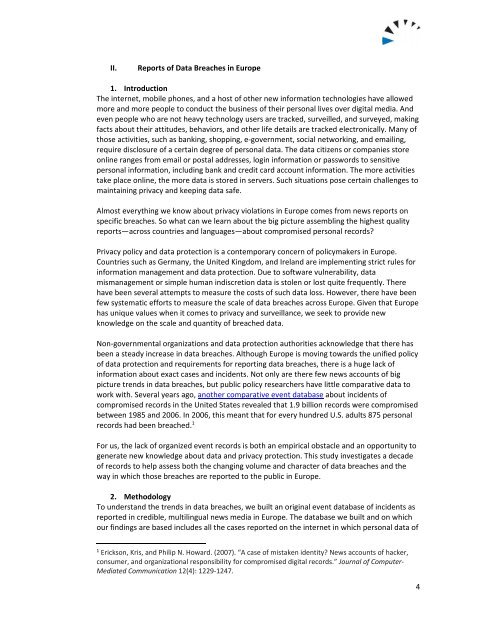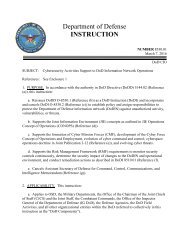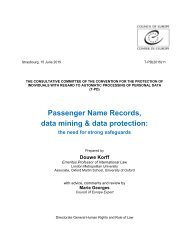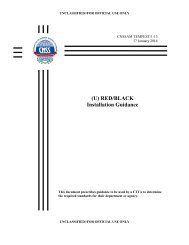data-breaches-in-europe
data-breaches-in-europe
data-breaches-in-europe
Create successful ePaper yourself
Turn your PDF publications into a flip-book with our unique Google optimized e-Paper software.
II.<br />
Reports of Data Breaches <strong>in</strong> Europe<br />
1. Introduction<br />
The <strong>in</strong>ternet, mobile phones, and a host of other new <strong>in</strong>formation technologies have allowed<br />
more and more people to conduct the bus<strong>in</strong>ess of their personal lives over digital media. And<br />
even people who are not heavy technology users are tracked, surveilled, and surveyed, mak<strong>in</strong>g<br />
facts about their attitudes, behaviors, and other life details are tracked electronically. Many of<br />
those activities, such as bank<strong>in</strong>g, shopp<strong>in</strong>g, e‐government, social network<strong>in</strong>g, and email<strong>in</strong>g,<br />
require disclosure of a certa<strong>in</strong> degree of personal <strong>data</strong>. The <strong>data</strong> citizens or companies store<br />
onl<strong>in</strong>e ranges from email or postal addresses, log<strong>in</strong> <strong>in</strong>formation or passwords to sensitive<br />
personal <strong>in</strong>formation, <strong>in</strong>clud<strong>in</strong>g bank and credit card account <strong>in</strong>formation. The more activities<br />
take place onl<strong>in</strong>e, the more <strong>data</strong> is stored <strong>in</strong> servers. Such situations pose certa<strong>in</strong> challenges to<br />
ma<strong>in</strong>ta<strong>in</strong><strong>in</strong>g privacy and keep<strong>in</strong>g <strong>data</strong> safe.<br />
Almost everyth<strong>in</strong>g we know about privacy violations <strong>in</strong> Europe comes from news reports on<br />
specific <strong>breaches</strong>. So what can we learn about the big picture assembl<strong>in</strong>g the highest quality<br />
reports—across countries and languages—about compromised personal records?<br />
Privacy policy and <strong>data</strong> protection is a contemporary concern of policymakers <strong>in</strong> Europe.<br />
Countries such as Germany, the United K<strong>in</strong>gdom, and Ireland are implement<strong>in</strong>g strict rules for<br />
<strong>in</strong>formation management and <strong>data</strong> protection. Due to software vulnerability, <strong>data</strong><br />
mismanagement or simple human <strong>in</strong>discretion <strong>data</strong> is stolen or lost quite frequently. There<br />
have been several attempts to measure the costs of such <strong>data</strong> loss. However, there have been<br />
few systematic efforts to measure the scale of <strong>data</strong> <strong>breaches</strong> across Europe. Given that Europe<br />
has unique values when it comes to privacy and surveillance, we seek to provide new<br />
knowledge on the scale and quantity of breached <strong>data</strong>.<br />
Non‐governmental organizations and <strong>data</strong> protection authorities acknowledge that there has<br />
been a steady <strong>in</strong>crease <strong>in</strong> <strong>data</strong> <strong>breaches</strong>. Although Europe is mov<strong>in</strong>g towards the unified policy<br />
of <strong>data</strong> protection and requirements for report<strong>in</strong>g <strong>data</strong> <strong>breaches</strong>, there is a huge lack of<br />
<strong>in</strong>formation about exact cases and <strong>in</strong>cidents. Not only are there few news accounts of big<br />
picture trends <strong>in</strong> <strong>data</strong> <strong>breaches</strong>, but public policy researchers have little comparative <strong>data</strong> to<br />
work with. Several years ago, another comparative event <strong>data</strong>base about <strong>in</strong>cidents of<br />
compromised records <strong>in</strong> the United States revealed that 1.9 billion records were compromised<br />
between 1985 and 2006. In 2006, this meant that for every hundred U.S. adults 875 personal<br />
records had been breached. 1<br />
For us, the lack of organized event records is both an empirical obstacle and an opportunity to<br />
generate new knowledge about <strong>data</strong> and privacy protection. This study <strong>in</strong>vestigates a decade<br />
of records to help assess both the chang<strong>in</strong>g volume and character of <strong>data</strong> <strong>breaches</strong> and the<br />
way <strong>in</strong> which those <strong>breaches</strong> are reported to the public <strong>in</strong> Europe.<br />
2. Methodology<br />
To understand the trends <strong>in</strong> <strong>data</strong> <strong>breaches</strong>, we built an orig<strong>in</strong>al event <strong>data</strong>base of <strong>in</strong>cidents as<br />
reported <strong>in</strong> credible, multil<strong>in</strong>gual news media <strong>in</strong> Europe. The <strong>data</strong>base we built and on which<br />
our f<strong>in</strong>d<strong>in</strong>gs are based <strong>in</strong>cludes all the cases reported on the <strong>in</strong>ternet <strong>in</strong> which personal <strong>data</strong> of<br />
1<br />
Erickson, Kris, and Philip N. Howard. (2007). “A case of mistaken identity? News accounts of hacker,<br />
consumer, and organizational responsibility for compromised digital records.” Journal of Computer‐<br />
Mediated Communication 12(4): 1229‐1247.<br />
4
















